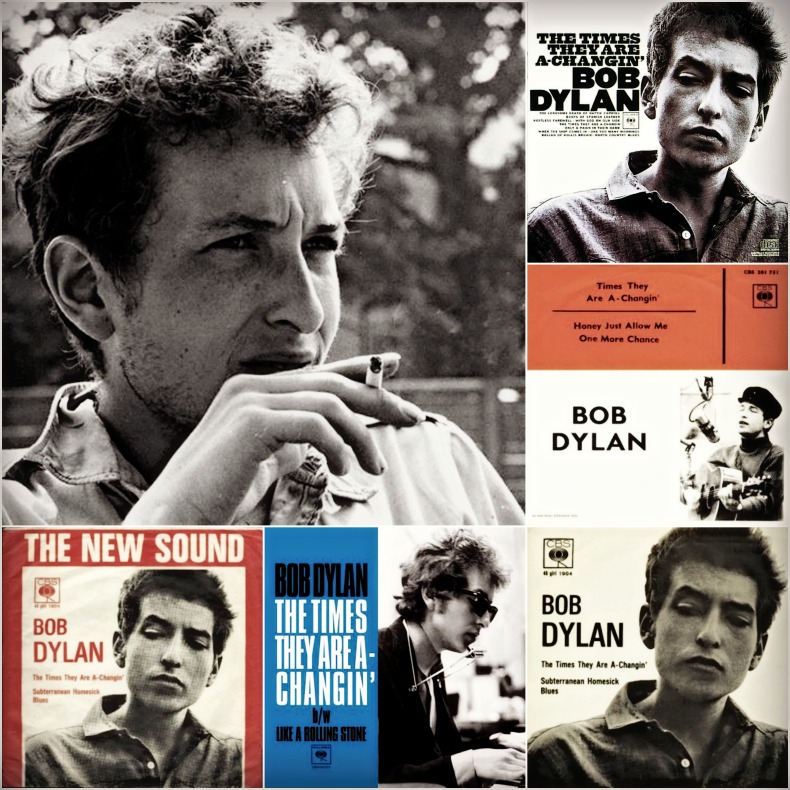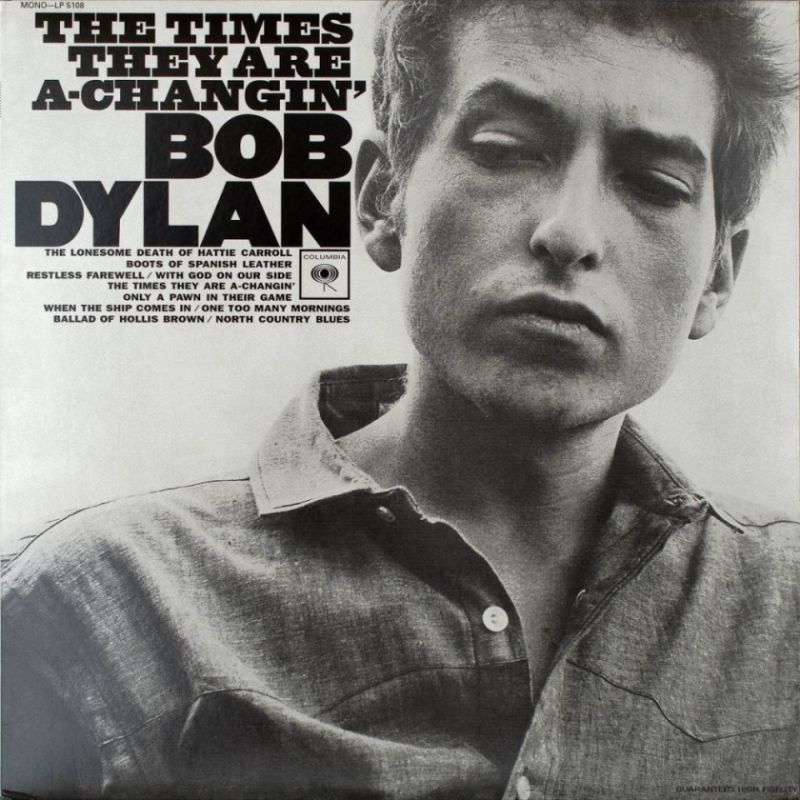
vimeo:
spotify:
TOC
@#31 on my list of Bob Dylan’s top 200 songs.
Facts

Wikipedia:
“The Times They Are a-Changin’” is a song written by Bob Dylan and released as the title track of his 1964 album of the same name. Dylan wrote the song as a deliberate attempt to create an anthem of change for the time, influenced by Irish and Scottish ballads. Released as a 45-rpm single in Britain in 1965, it reached number 9 in the British top ten.
Ever since its release the song has been influential to people’s views on society, with critics noting the general yet universal lyrics as contributing to the song’s lasting message of change. Dylan has occasionally performed it in concert. The song has been covered by many different artists, including Nina Simone, the Byrds, Peter, Paul, and Mary, Simon & Garfunkel, the Beach Boys, Joan Baez, Phil Collins, Billy Joel, and Bruce Springsteen. The song was ranked number 59 on Rolling Stone‘s 2004 list of the “500 Greatest Songs of All Time”.
Known studio recordings:
Studio A, Columbia Recording Studios, NYC
- October 23, 1963 – 6 takes
– take 1 or 6 released on bonus disc on the limited edition of LOVE AND THEFT, Columbia CK 86076, 11 September 2001 - October 24, 1963 – 1 take
– first released on THE TIMES THEY ARE A-CHANGIN’, Columbia CL-2105, CS-8905, 13 January 1964.
Musicians:
- Bob Dylan: vocals, guitar, harmonica
Technical Team:
- Producers: Tom Wilson
- Sound Engineer: George Knuerr and Pete Dauria
Live:
- First known performance: Carnegie Hall, New York City, New York – 26 October 1963
- It has been performed 633 times live – last performance: Chukchansi Park, Fresno, California – 14 August 2009
- Top year 1992 with 69 performances
Quotes
I knew exactly what I wanted to say and who I wanted to say it to…. This was definitely a song with a purpose. It was influenced of course by the Irish and Scottish ballads …’Come All Ye Bold Highway Men’, ‘Come All Ye Tender Hearted Maidens’. I wanted to write a big song, with short concise verses that piled up on each other in a hypnotic way. The civil rights movement and the folk music movement were pretty close for a while and allied together at that time.”
– Bob Dylan (liner notes to 1985’s Biograph)
The first time a lot of pop fans noticed Dylan was when the ‘The Times They Are a-Changin’’ came out as a single in 1964. To pop-trained ears, it was a laughable record. The singer had a voice that made Johnny Duncan and the Blue Grass Boys sound like Mario Lanza—and plainly, he hadn’t even the most elementary sense of timing. He brought in the second syllable of that title word ‘Changin’’ far too soon: at a quite ridiculous point. What was the record company playing at? Just because Bob Dylan was the writer of an interesting song called ‘Blowin’ in the Wind’ didn’t mean he could expect to start singing all his other songs himself . . . To others, the striking thing was that here was someone who wasn’t just pop-singing, but truly communicating.
~Michael Gray (The Bob Dylan Encyclopedia)
He succeeded. “The Times They Are A-Changin’ ” expresses a feeling that was in the air but had not yet been put into words (not in a popular, accessible medium), that all these political and cultural (and personal) changes going on were part of one large Movement, a sea change, something of historical proportions, the sort of thing spoken of in biblical prophecy. This song may have been the decade’s first public identification ofwhat later came to be called the “generation gap”-the new road ofthe children against the old road oftheir parents. Dylan took his own advice, seized the chance and wrote a hymn that would continue to be relevant throughout the changes ofthe next six years (at least). Naming the album after the song was a natural move, and served to heighten the dramatic impact of both album and song.
– Paul Williams – Bob Dylan Performing Artist I: The Early Years 1960-1973
Genuine modern broadsheet writing, this epic outburst of the early Sixties youth renaissance still thrills with its quasi-biblical prophecy of a new era just coming into flower.
– Ian MacDonald (Uncut Magazine – Bob Dylan’s 40 best songs)
Dark words, bright words of ice and fire, as if an angel did desced and use the writer as a pen.
– Mike Scott (Uncut Magazine – Bob Dylan’s 40 best songs)
When people describe Dylan as the “spokesman of a generation,” they are thinking of the man best defined by “The Times They Are A-Changin’.” And while Dylan would later bluntly reject that title, he consciously sought it with this passionate anthem. A masterpiece of political songwriting, it addresses no specific issue and prescribes no concrete action, but simply observes a world in violent upheaval. (That the song was released just months after the assassination of John F. Kennedy only lent it more power.) Dylan sings in the voice of a bard or prophet, in cadences that are clearly biblical – in his words, “short, concise verses that piled up on each other in a hypnotic way.”
– RollingStone Magazine – 100 Greatest Bob Dylan Songs
Lyrics
Come gather ’round people
Wherever you roam
And admit that the waters
Around you have grown
And accept it that soon
You’ll be drenched to the bone
If your time to you is worth savin’
Then you better start swimmin’ or you’ll sink like a stone
For the times they are a-changin’
Come writers and critics
Who prophesize with your pen
And keep your eyes wide
The chance won’t come again
And don’t speak too soon
For the wheel’s still in spin
And there’s no tellin’ who that it’s namin’
For the loser now will be later to win
For the times they are a-changin’
Come senators, congressmen
Please heed the call
Don’t stand in the doorway
Don’t block up the hall
For he that gets hurt
Will be he who has stalled
There’s a battle outside and it is ragin’
It’ll soon shake your windows and rattle your walls
For the times they are a-changin’
Come mothers and fathers
Throughout the land
And don’t criticize
What you can’t understand
Your sons and your daughters
Are beyond your command
Your old road is rapidly agin’
Please get out of the new one if you can’t lend your hand
For the times they are a-changin’
The line it is drawn
The curse it is cast
The slow one now
Will later be fast
As the present now
Will later be past
The order is rapidly fadin’
And the first one now will later be last
For the times they are a-changin’
Live versions
CBC TV Studios
Toronto, Ontario, Canada
1 February 1964
Produced by Daryl Duke.
–
Nippon Budokan Hall
Tokyo, Japan
23 February 1978
- Bob Dylan (vocal & guitar)
- Billy Cross (lead guitar)
- Alan Pasqua (keyboards)
- Steven Soles (rhythm guitar, backup vocals)
- David Mansfield (violin & mandolin)
- Steve Douglas (horns)
- Rob Stoner (bass)
- Bobbye Hall (percussion)
- Ian Wallace (drums), Helena Springs, Jo Ann Harris, Debbie Dye (background vocals)
–
Drammenshallen
Drammen, Norway
10 July 1981
- Bob Dylan (vocal & guitar)
- Fred Tackett (guitar)
- Steve Ripley (guitar)
- Willie Smith (keyboards)
- Tim Drummond (bass)
- Jim Keltner (drums)
- Clydie King, Carolyn Dennis, Regina Havis, Madelyn Quebec (background vocals)
Bob puts something into “The times They Are A-Changin’” that is unique to the evening. It’s not the way he sings the song, in any tecnical sense, but rather the feeling he manages to communicate. There is a sincerity in his singing, an unusual degree of conviction, a fresh, bright enthusiasm often associated with springtime.
~Paul Williams (BD Performing Artist 1974-86)
–
Muziekcentrum Frits Philips
Eindhoven, The Netherlands
17 February 1993
Musicians:
- Bob Dylan (vocal & guitar)
- Bucky Baxter (electric mandolin)
- John Jackson (guitar)
- Tony Garnier (bass)
- Winston Watson (drums & percussion)
- …and Liz Souissi (shared vocals)
–
Milwaukee Arena
Milwaukee, Wisconsin
30 October 1999
- Bob Dylan (vocal & guitar)
- Charlie Sexton (guitar)
- Larry Campbell (guitar, mandolin, pedal steel guitar & electric slide guitar)
- Tony Garnier (bass)
- David Kemper (drums & percussion)
–
Newcastle Arena
Newcastle, England
19 September 2000
- Bob Dylan (vocal & guitar)
- Charlie Sexton (guitar)
- Larry Campbell (guitar, mandolin, pedal steel guitar & electric slide guitar)
- Tony Garnier (bass)
- David Kemper (drums & percussion)
–
Cardiff International Arena
Cardiff, Wales
6 May 2002
- Bob Dylan (vocal & guitar)
- Charlie Sexton (guitar)
- Larry Campbell (guitar, mandolin, pedal steel guitar & electric slide guitar)
- Tony Garnier (bass)
- Jim Keltner (drums & percussion)
–
Lancaster, Pennsylvania
Clipper Magazine Stadium
June 19, 2005
- Bob Dylan – keyboard, harp
- Stu Kimball – lead guitar
- Denny Freeman – guitar
- Donnie Herron – electric mandolin, pedal steel, lap steel
- Tony Garnier – bass
- George Recile – drums
–
East Room
The White House
Washington, District Of Columbia
11 February 2010
Performance at the White House:
A Celebration of Music From the Civil Rights Movement
- Bob Dylan (acoustic guitar & vocal)
- Patrick Warren. (piano)
- Tony Garnier (bass)
–
>xxx>
xx
—
On January 24, 1984, during the annual shareholders’ meeting of Apple, Steve Jobs began his speech by introducing the original Macintosh with the second verse of “The Times They Are A-Changin’.”
–
Cover Versions
Don Henley (live, 1993):
–
Tracy Chapman:
–
Bruce Springsteen – 1997 Kennedy Center Honors:
–
Keb’ Mo’:
–
Joan Baez:
–
–
Sources
- Bob Dylan – The Lyrics: Since 1962
- Philippe Margotin & Jean-Michel Guesdon – Bob Dylan All the Songs: The Story Behind Every Track
- Michael Gray – The Bob Dylan Encyclopedia
- Clinton Heylin – Revolution in the Air: The Songs of Bob Dylan, 1957-1973
- Paul Williams – Bob Dylan Performing Artist I: The Early Years 1960-1973
- Uncut Magazine – Bob Dylan’s 40 best songs
- MOJO Magazine – Mojo – The 100 greatest Dylan songs (september 2005)
- RollingStone Magazine – 100 Greatest Bob Dylan Songs
- Wikipedia
- Olof’s – Still On The Road
- bobdylan.com
-Egil

What a joy for Bob when Patty Smith surprises him on the song ; she is perhaps his senior , but well known by Dylan. Yeah right “ Bob ‘s timing is terrible “says the critic. He had just done his very first recording. Bob’s learning curve is straight up; comeback a couple months later guy!
Talking with fellow fans, I often find people look down their noses at this song a bit nowadays.. writing it off as overly simplistic.. I love it! Maybe I’m just overly simple 😉